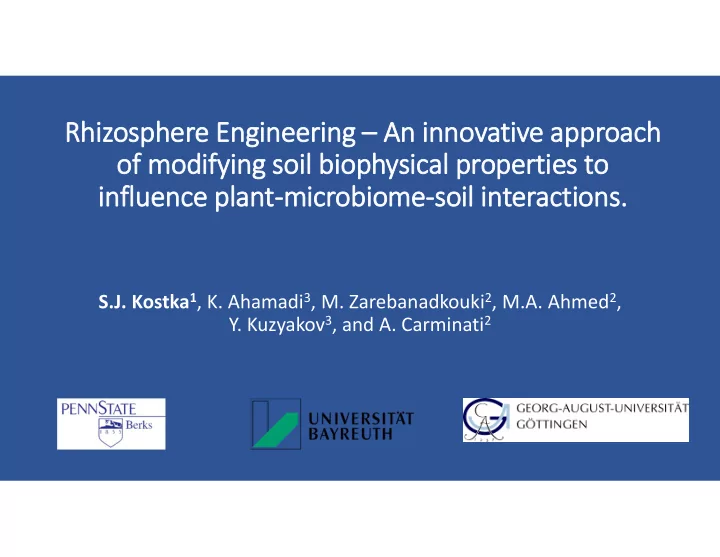

Rhizosphere Engineering – An innovative approach of modifying soil biophysical properties to influence plant-microbiome-soil interactions. S.J. Kostka 1 , K. Ahamadi 3 , M. Zarebanadkouki 2 , M.A. Ahmed 2 , Y. Kuzyakov 3 , and A. Carminati 2
What is the rhizosphere? The rhizosphere is the zone of soil surrounding a plant root where the biology and chemistry of the soil are influenced by the root. • a few mm wide. • an area of intense biological and chemical activity influenced by compounds exuded by the root (mucilage), and by microorganisms • communication between the plant and the microbiome Photo credit: Phillipott et al, Nature Rev Microbiol, 2013. Mucilage
Mucilage - The hydraulic bridge between soil and roots Root Courtesy of M. McCully Relevant processes: • Root hairs increase the root surface, decreasing the solute concentration per unit root surface area • Mucilage keeps the region between root hairs wet. • Carminati et al, 2016 Mucilage and root hairs maintain the hydraulic contact between roots.
Neutron radiography of Lupine water distribution near roots More water near roots θ 5 cm 0.4 θ Day 3 -Drying dist to root 0.01 Carminati and Vetterlein, 2013
Neutron radiography of Lupine water distribution near roots More water near roots θ 5 cm 0.4 θ Day 3 -Drying dist to root Less water near roots 0.01 θ Day 5 -1 hour after rewetting dist to root Carminati and Vetterlein, 2013
What happens in corn? Soil water content (v:v) Ahmed et al, 2017
What’s going on in the rhizosphere? Moradi et al, 2012 Carminati et al, 2014 Carminati et al, 2016
Mucilage in pore spaces Mucilage secreted by roots and EPS produced by microorganisms alter the physical properties of the soil solution and impact water dynamics in the rhizosphere. High viscosity mucilage and EPS form thin filaments and interconnected thin lamellae that span throughout the soil matrix. Source: Water percolation through the rhizosphere - effect of heterogeneous pore scale wettability Pascal Benard , Zarebanadkouki Mohsen, Carminati Andrea Soil Physics, University of Bayreuth Benard et al, Vadose Zone J, 2017
Can the rhizosphere be engineered? Lupine Untreated “Rhizoligand” (50 ppm) • Rhizoligand treatment - Cross-linked the mucilage biopolymer results in: • Increased speed of rhizosphere rewetting after drying • Reduced mucilage expansion and total water content in mucilage Carminati et al, 2016 • Limited diffusion of mucilage resulting in better root- Ahmed et al, 2017 soil contact
• Modified plant transpiration rate • Delaying onset of wilting (up to 2 days) in moncots and dicots. Water Rhizoligand Carminati et al, 2016 Ahmed et al, 2017
• Rhizosheaths increased significantly (up to 1.6-fold) Rhizoligand Water Lupine Ahmed et al, 2017 Ahmadi et al, 2017 Ahmadi et al , in press Tall fescue Photo credit: K Ahmadi
• • Increased root mass Increased rhizosheath C Rhizoligand Water • Increased microbial biomass Ahmed et al, 2017 Ahmadi et al, 2017 Ahmadi et al , in press
• Rhizoligand treatment influenced plant and rhizobiome enzymes • Soil health • Plant health Corn Lupine Ahmadi et al, 2017; Ahmadi et al , in press
Rhizosphere Engineering Untreated “Rhizoligand” (50 ppm) Conclusions: • Rhizosphere stabilization - Cross-linking of mucilage resulting in: • Increased speed of rhizosphere rewetting after drying Carminati et al, 2016 Ahmed et al, 2017 • Reduce mucilage expansion and total water content Ahmadi et al, 2017 • Limited diffusion of mucilage resulting in better root-soil contact Ahmadi et al , in press • Modified plant transpiration rate, delaying onset of wilting (up to 2 days) • Increased rhizosheaths significantly (up to 1.6-fold in monocots) • Increased root mass (monocts and dicots) • Increased soil enzymes related to soil and plant health - chitinase, sulfatase, and β-glucosidase • Positive rhizobiome effects – Microbial biomass increased (+57%)
Stan Kostka stan.kostka@gmail.com Roots play an essential role in the acquisition of water and minerals from soils. Modifications to roots result in higher yield and increased stress tolerance. Strategies to manipulate the rhizosphere and the rhizobiome will enhance soil and plant health, and crop productivity. Photo: Dept of Plant Science - PSU
Recommend
More recommend